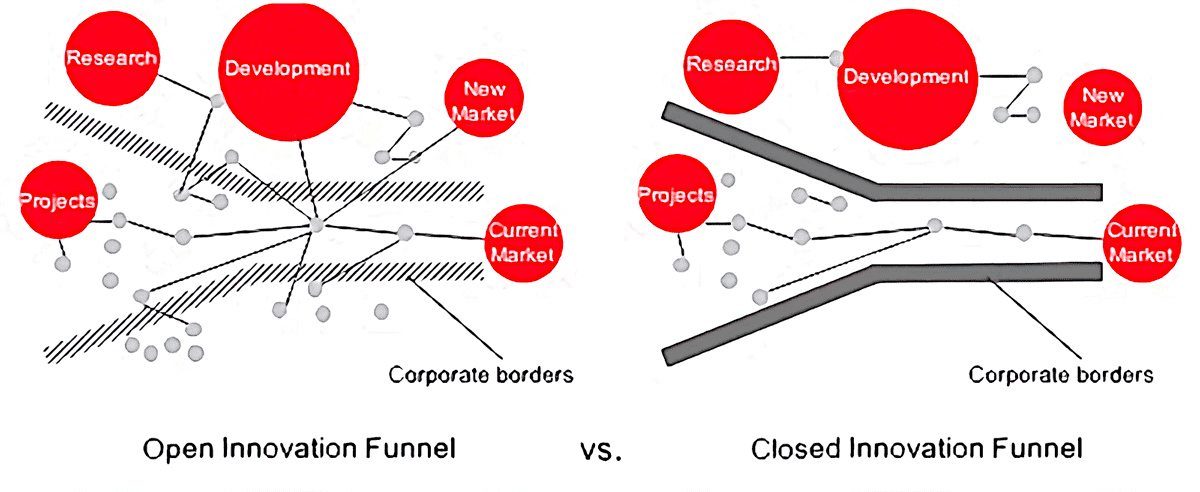In the context of digital transformation we are witnessing in recent years the development of business units, within (or outside) large organizations, aimed at creating products or services in a technological key to be competitive in the increasingly liquid contemporary world.1
For some years now, we have been witnessing the development of digital and innovation units, often called Labs, within large international companies such as Samsung, BMW, Lufthansa, Unilever and many others in different sectors. These multinationals, with traditional working environments and corresponding to classic hierarchical structures, seek to dominate the digital transformation. Their goal is to remain competitive in rapidly changing markets with new technologies and unpredictable new business models. But reinventing themselves and developing new organizational structures that enable the creation of new and innovative products and services proves to be one of the biggest challenges of the 21st century.
The main solution: create internal start-ups to create new business models, disrupt existing approaches and access new business fields in a short period of time.
However, launching a tech startup within the context of a structured company isn't just adding salt to the soup. It's much more than that: you need a whole recipe with the right ingredients.
The central question is: what influences the success of internal startups?
Through my empirical study in 2017, which included interviews with venture capitalists, innovation lab managers, and startup CEOs, I found five key success factors for enabling startups to grow within companies.
# 1: Create an innovative environment
CEO SupportThe support of the CEO in line with the overall company strategy is mandatory to establish an independent innovation unit. Activities must be closely aligned with the strategic objectives and business processes of the entire company, as well as officially promoted by the CEO in professional networks, social media, press and on the company's website.
Building a future-oriented corporate culture: Identify and define their corporate culture at all levels of the hierarchy and define their position between a more conservative and a more visionary way of acting. With a more classical mindset, companies tend to define markets for a specific industry. In contrast, a more visionary mindset tends to focus on potential business models - taking higher risks, focusing on radical innovations and defining markets more broadly. For these reasons, innovation leaders need to be appointed across divisions and departments to spread innovation.
# 2: Setting up an innovation lab
Establish clear objectives: Specific qualitative and quantitative objectives allow the company to target and measure innovation more effectively.
Ensure high autonomy of teams: A high level of autonomy should be given to all project teams, as they generally know the best way to think about and develop the project in order to achieve the overall objectives.
Focus on specific business areas: While many companies lose interest shortly after starting their innovation lab, successful companies focus on certain activities to expand their product portfolio. This brings more organization and better defines the areas on which to focus innovation.
Decentralized business units: Decentralized units help you to be more effective in organizing your IT development and human resources teams. It also promotes greater independence from the C-level and allows for greater autonomy in decision-making, which generally increases the quality of innovation work.
Hire the right people: One of the most important factors in shaping the innovation business is the employees. Framing the right team and keeping them motivated is crucial to the overall outcome. My analysis shows that companies with a diverse workforce have more creative output. Attributes for smart creative employees include playfulness, flexibility and openness combined with a high energy level and a risk-taking attitude. In addition, business leaders need to be more tolerant of those who are somehow "different" but have extraordinary talents to contribute to the cause.
Manage your stakeholders: Smart innovators understand that successful innovation can only be achieved if they manage and care about the potential stakeholders within their company. A new technology or business model will never be successful if it does not convince the decision makers in the company. Although innovation managers are in their comfort zone within the lab, they must always strengthen their relationships with potential decision makers and supporters of the initiative to make things grow.
# 3: Start a development program
Provide cooperation: By initiating a startup development program you can provide a privileged communication channel for collaboration with the parent company. This increases the chances of being the first to benefit from any positive product or service developments and increases the overall attractiveness of the company because it qualitatively and quantitatively demonstrates the parent company's interest in innovation issues.
Work on engaging communication: Get more traction by giving the startup access to your customer base, business angels and contacts in Silicon Valley or startup ecosystems.
You offer exceptional support: By providing office space, technical infrastructure, mentorship, strong support and the opportunity to work on cutting-edge technologies, it offers startups what they need at the conception stage.
# 4: Design an innovation process
In order to ensure a channeling of innovation, I would recommend creating an open innovation process. This way, external innovators can be integrated into the development of new products and services. In the ideal case, the potential customer is directly asked for feedback at as many stages of the development process as possible.

Collaboration with external stakeholders should be implemented at every stage of the innovation process. For the definition of research fields, during idea generation, for development, testing and market launch, it is useful to interview participants and involve pilot customers.
# 5: Implementing a process of integration
Use the results: most companies have not defined a clear framework for bringing products or business models back from the innovation lab to the parent company or turning them into a standalone division or subsidiary. As a result, management is often unprepared to handle startup scale-up and customer demand for the product or service. For a startup project leader within a corporate context, the following structure should provide guidance in this process:
Important factors for integrating start-ups into corporate structures

- Develop an action plan
To administer, organize, and harmonize the steps following the integration of the startup, prepare an action plan that everyone can review and that will be discussed in the weekly corrections. To structure the plan, keep in mind the following topics: organizational structure, human resources, internal communication, legal aspects, budget, IT, product portfolio, branding, website.
- Planning the organizational structure
There are three actionable ways to grow the startup in the context of a larger, more structured company:
- Integration within a related business unit
- The creation of a completely new division
- Spinning off by creating a spin-off
- Contact a transformation/innovation manager
This highly interconnected, high-level professional acts as an intermediary and liaison between management and the innovation lab, thus coordinating the strategic orientation of the start-up. The transformation manager also points out which activities or processes can be harmonised and where synergies could arise.
- Harmonize processes
In the case of integrating the startup into a business unit, the probability of diminishing quality performance due to forced adaptation into classic business processes is relatively high. Therefore, in the kickoff, one should keep the processes unchanged and try to harmonize them later with the business processes.
- Promoting permanent communication
The integration of the startup into a business unit or spin-off in the SME/corporate context creates uncertainty within the startup team. This may result in employees being unable to communicate their opinion or possible dissatisfaction. This in turn generates a sharp drop in performance within the team. Therefore, one of the success factors in startup transfer is permanent communication in order to give employees a sense of security during the integration or spin-off phase.
- Promoting a culture of failure
Exceptional results are easier to achieve in an environment where mistakes are accepted, gaining courage, independence, proactivity or speed. Startups often encourage this culture. In contrast, corporate culture tends to be more risk-averse, and employees usually protect themselves behind excessive perfectionism in executing the standard process, which is ill-matched to the adoption of often more optimal innovative processes.
In summary, it is necessary to create a functional ecosystem for startups to grow within a company. Considering all the factors mentioned above, companies should be prepared to innovate and self-power. To foster innovation, employees need the courage to embrace change and the power to make a difference within the organization.




